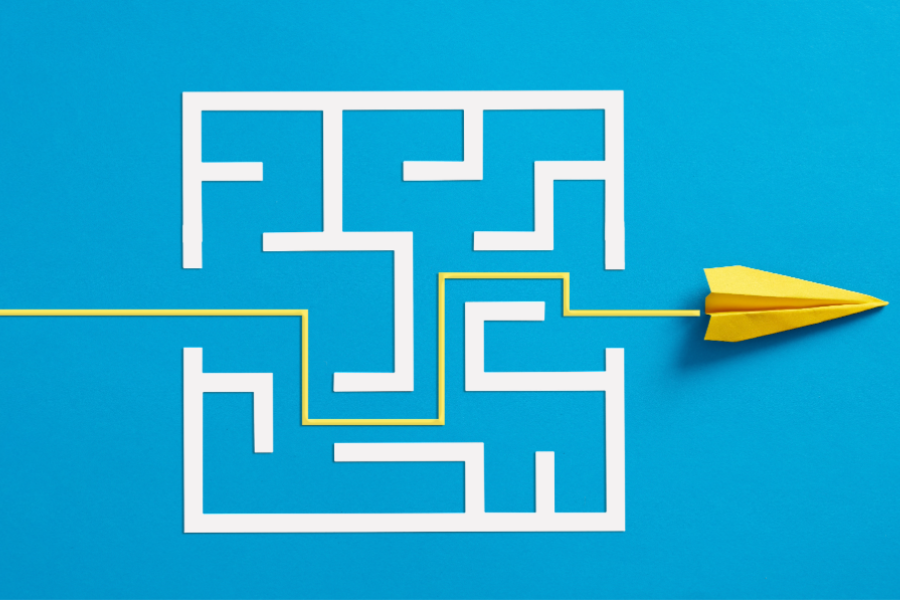In the first article, we discussed how there can be a gap between our habits and our conscious intentions, beliefs, and attitudes. However, instead of being at the mercy of automaticity, we found we can condition our habits to align with our goals.
In this article, we will explore why habits are notoriously challenging to break or intentionally establish. It’s probable that everyone reading this article has encountered the difficulty of trying to condition new habits or dismantle old habits. If you’ve been frustrated by the struggle of changing your habits, you’re certainly not alone.
This article will provide insights and five reasons why habits are difficult to change, and it will start to address how we can overcome those challenges effectively. By utilizing the most up-to-date evidence and methods, our aim is to assist you in aligning your habits with your goals, making the journey from intention to action a little less bumpy.
First, as a small note before diving in, this article (and the rest of this series) will be discussing purposeful habit change. Technically, it’s very easy to change your habits. It happens all the time without you even realizing it. However, most of those changes are non-purposeful changes. Some may be helpful for your goals, and some may hinder your goals, but most will be completely neutral. For example, you used to habitually put on your right shoe before your left shoe, and now you habitually put on your left shoe before your right shoe, even though you didn’t make a conscious effort to switch up the order. Why? We may never know.
In this series, we’re dealing with purposeful habit change – intentionally trying to form new habits that support your goals, or intentionally trying to break or replace habits that hinder your goals. This may seem like a very basic distinction, but it’s an important one. You will wind up with some set of habits by chance, but ending up with the set of habits you want to have is considerably tougher, and requires effort.
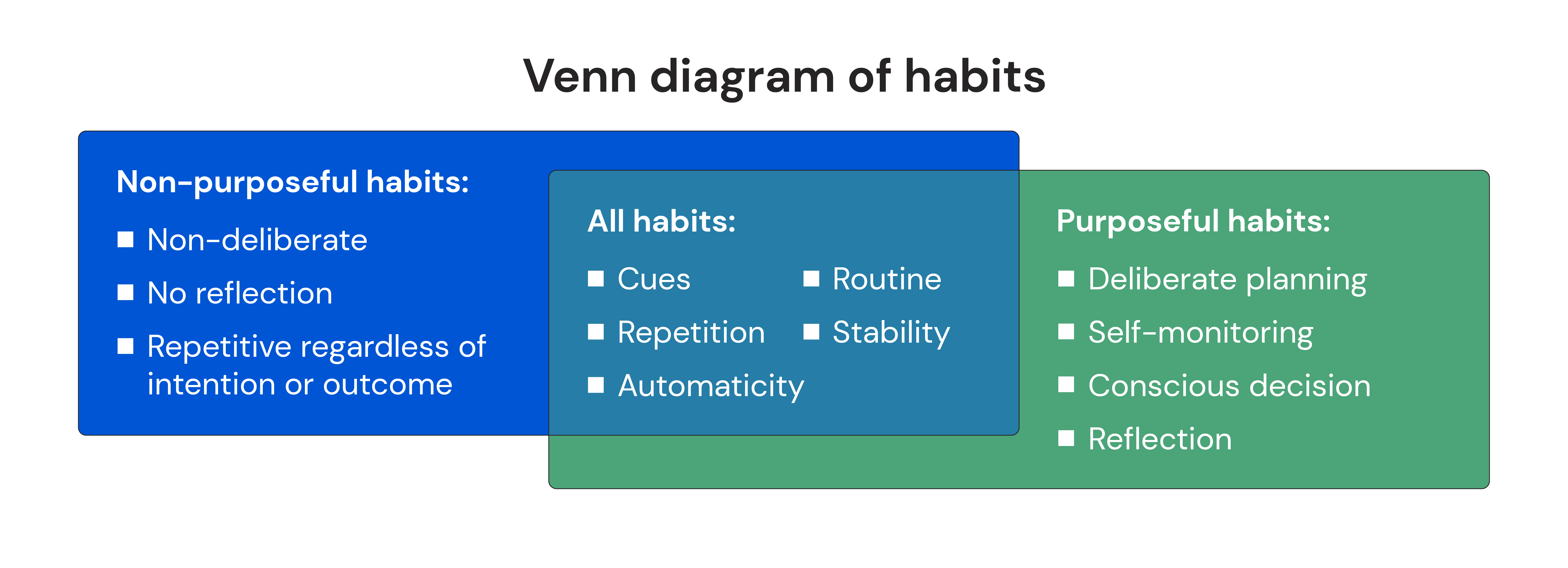
So, why is it so tough to purposefully change your habits? Let’s dive in and find out.
Reason #1: Purposeful habit change takes strong intentions
Purposeful habit conditioning is strongly influenced by goal setting and motivation. We’ve discussed goal-setting extensively in the article “Accomplishing Goals Through Sustainable Behavior Change,” where we lay out the theoretical foundations and a framework for goal construction. While not essential for understanding this article, it’s recommended as a companion resource for a more comprehensive understanding.
Without successful behavior change, the formation of habits cannot occur. And embedded within the framework of any commitment to behavior change are intentions. Understanding intentions and the factors contributing to their failure is crucial; without this insight, achieving goals becomes challenging.
Why?
Before a new behavior can become habitual (automatic and virtually effortless), you typically need to consciously carry out the behavior many times, which requires focus, awareness, and some degree of effort. Manipulating our short-term conscious behavior is relatively easy and straightforward, but manipulating our conscious behavior consistently enough, and over a long enough period of time to condition our subconscious to act as we desire automatically? That’s a bit trickier. It requires sustained effort that won’t occur without strong intentions.
Habit formation requires time and effort. A lot of it. Persisting with cues and actions for weeks or months may not be enough; some habits can take almost a year to establish. Therefore, we must be committed to the intentions of the habits we are trying to automate.
This point may seem trite, and almost too basic, bordering on cliché. It may sound dangerously close to the mumbo jumbo you’d hear from a motivational speaker (“You just have to want it bad enough!”). But, strong intentions are the necessary starting point for purposeful habit change. With weak intentions, you’ll certainly still carry out a new behavior a few times, but you’ll be far more likely to give up and revert back to your old habits when you face setbacks. It may take weeks, or even months, to condition a new habit. During that time, it won’t always be easy to carry out the behaviors you’d like to become habitual, and there’s a very good chance you’ll occasionally slip back into your old habits while you’re trying to build new ones. Strong intentions provide you with the push you need to persist when the going gets tough.
But, while strong intentions are necessary for habit change, they aren’t sufficient. Strong intentions help you persist through the process of purposeful behavior change, but you do still need to change your conscious behaviors, and maintain those new behaviors long enough for them to become habitual. So, let’s turn our attention to behavior change.
Reason #2: Habit formation requires behavior change
Since new habits start as new conscious behaviors, we can’t discuss habits without discussing behavior change. For a primer, (purposeful) behavior change is the active process of using behavior change techniques (BCTs) for self-improvement. These techniques span a wide range from goal setting to self-monitoring to transtheoretical models. It’s sort of a big self-improvement bubble. If we condition habits—recognizing that habit theory itself constitutes a BCT—those new habits provide an automatic neurological response even if motivation is waning.
Since you’re reading this on MacroFactor’s site, you’re likely interested in applying BCTs and changing your habits to help with weight management, healthy eating, and/or physical activity. Unfortunately, not all new behaviors to support goals and those domains can become fully subconscious and habitual; of the behaviors you change to support those goals, some will become habitual, while some will remain conscious behaviors (that’s especially true for physical activity).
For example, if you had a goal of consistently brushing your teeth every morning, you could definitely reach the point where brushing your teeth is completely subconscious and habitual. My brain is barely functioning when I’m carrying out my morning routine, but I still complete it exactly the same way every day, with virtually no conscious thought. However, a habit of healthier snacking would still need to be supported by the conscious choice of buying healthier snacks. The act of munching on apples instead of potato chips may become habitual, but you still need to consciously decide to keep apples around the house in place of potato chips. Or, the process of getting dressed to work out as soon as you get home from work or school may become habitual, but active thought and decision making is still required to actually complete your workout.
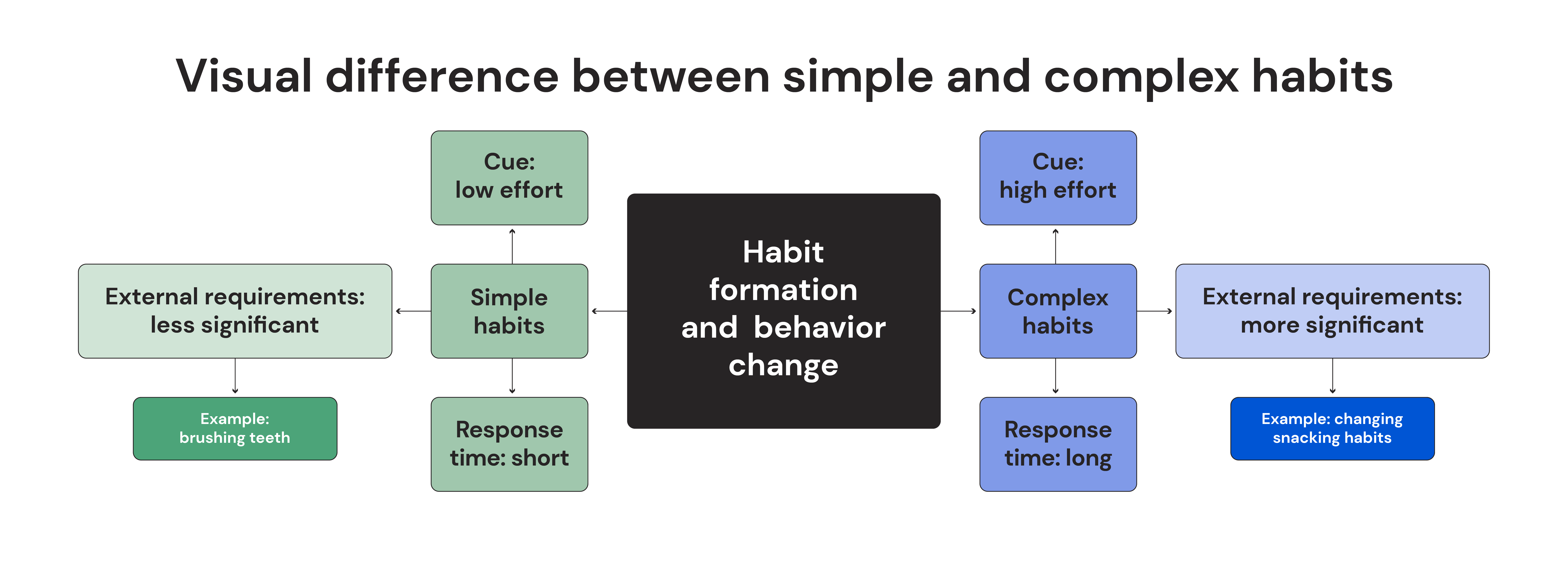
New behaviors become effortless once they can become fully automatic and habitual. But, new behaviors require effort before they can become habitual. Furthermore, when you’re trying to modify a set of behaviors, and only some of those new behaviors can become fully habitual, ongoing maintenance of your new behaviors will still require effort. The new habits you build will certainly make the remaining conscious behaviors easier, but they’ll still require focus and energy.
Because of that, routines will be a blend of subconscious firing mixed with ongoing efforts to modify and sustain new conscious behaviors. This is one reason why this section of the article series is so important. To change habits means changing behavior with purposeful intentions.
Reason #3: Internal and external factors can create an “intention-behavior gap”
So, to pause for a moment, if you’ve reached this point of the article series, you’re probably thinking, “Look, I intend to change my behaviors and pursue this habit. But how do I actually do it?”
Bear with me a little longer.
When we investigate intentions (because most people are already filled with intentions), we must understand why intentions aren’t always enough. To do this, we must examine the intention-behavior gap.
The intention-behavior gap is the discrepancy between an individual’s intentions to execute specific actions versus their automatic behavior. For example, you intend to walk for 30 minutes every day, but after repeated attempts (and despite your best intentions), you’re still not walking for 30 minutes every day. Why does this happen? You believe you’re ready to change your behavior, having committed to purposefully enact this change. You’ve attempted to form what you thought were new and better habits. What’s the issue? Why does the expected change not materialize?
Understanding why habits fail requires examining intention-behavior moderators. If intentions represent the plan, moderators are the elements that influence the plan’s execution. For example, if your intention is to take a 30-minute daily walk, one moderator could be the perceived safety of your neighborhood. Another moderator might be the perception that committing 30 minutes is too demanding. Alternatively, you might discover that when you notice your shoes by the door, you’ve already committed to another activity. Moderators encompass various factors, ranging from past habits to regret to difficulty of the habit goal itself.
Below is a list of Moderators from Connor and Norman that highlights all the factors that can affect intentions. The descriptions and examples have been simplified from the originals for easier understanding.
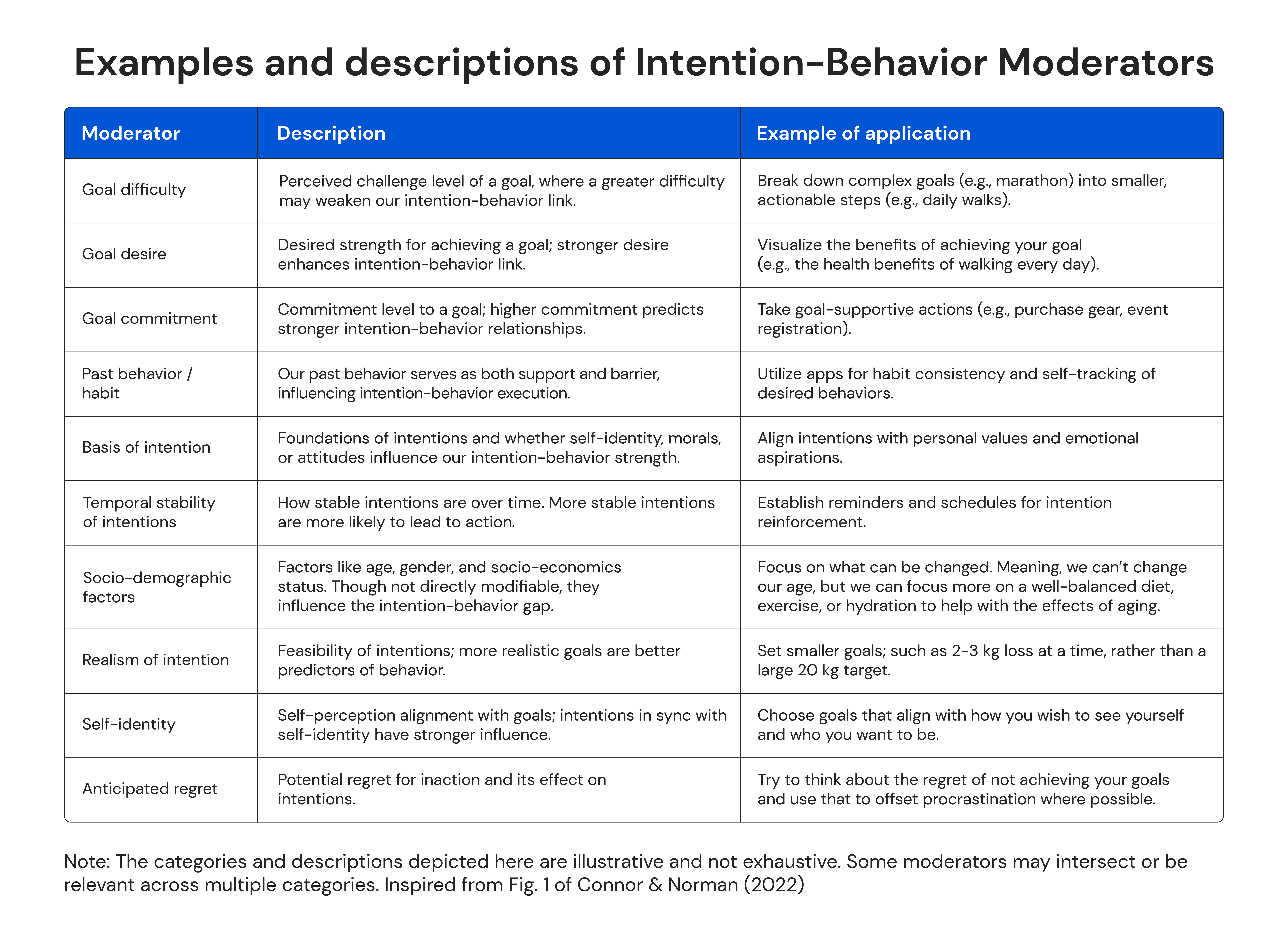
As you see, if you look at that list alone, it’s … basically everything in your life and your psychological makeup. Each of those factors could represent a potential (surmountable) barrier to make behavior change and habit modification more difficult.
In research, we look at these gaps and moderators alongside behavior theories to get a snapshot of why things don’t always go according to your plan. A 2023 study by Feil et al conducted a systematic review and meta-analysis of the intention-behavior gap in strengthening habits for physical activity. The meta-analysis included data from 25 independent samples, taken from 22 articles, with a total of 29,600 participants. These participants were drawn from various backgrounds, including students, parents, and adults at health risk, representing a wide range of the general population interested in or advised to engage in physical activity for health benefits.
The main purpose of the study was to examine the gap between intending to do physical activity and actually doing it. They also wanted to find out what factors might influence the size of this gap. To clarify, a larger gap indicates individuals failed to translate their intentions into action. The smaller the gap, the better their intentions were applied. The study identified four profiles based on the participant’s intentions and behaviors:
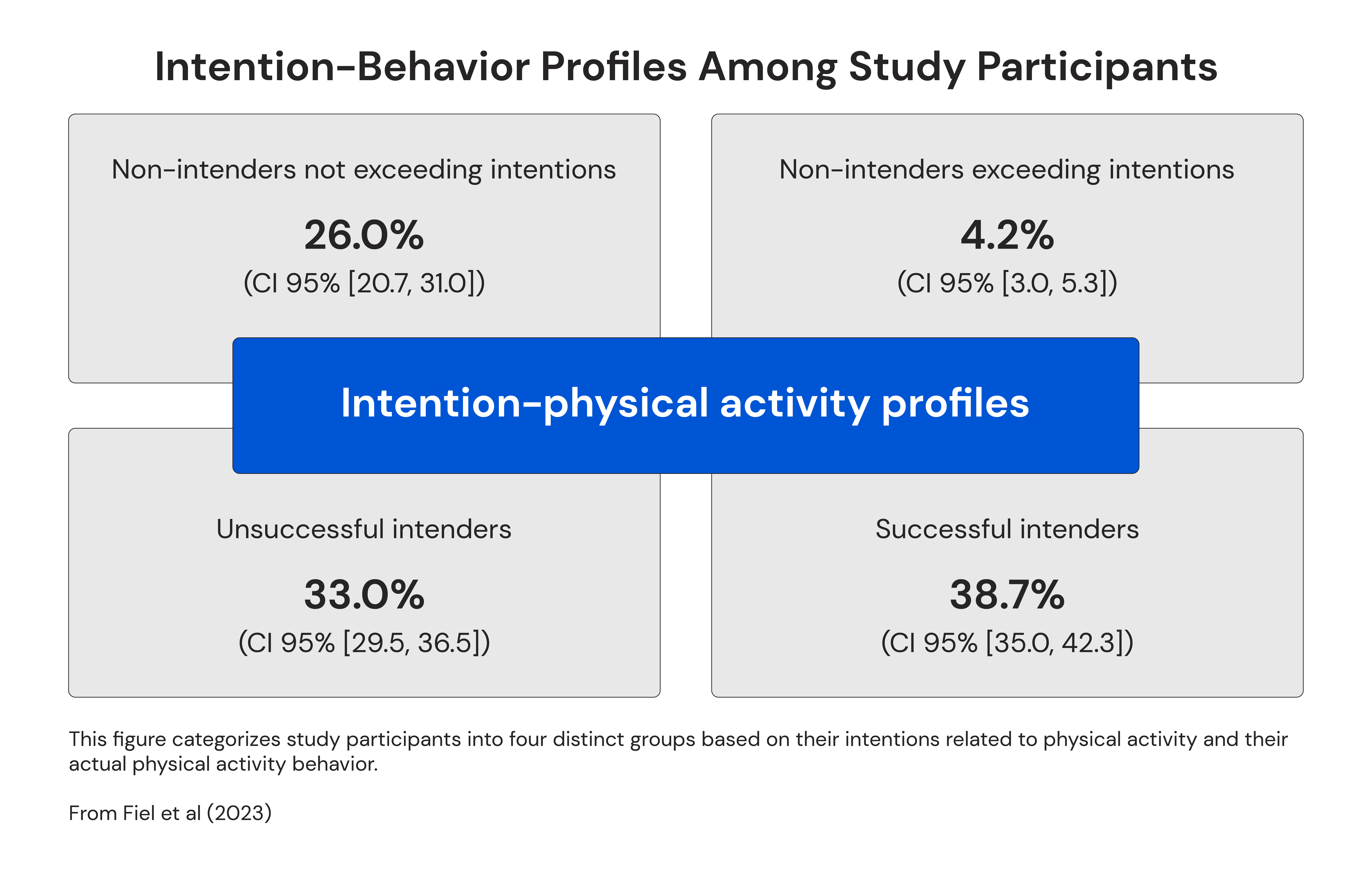
The overall intention-behavior gap was quantified at 47.6%, implying nearly half of the individuals intending to be physically active did not follow through on their intentions. This produced outcomes similar to a 2013 study that found a 46% intention gap for physical activity. The study also found college students showed the largest intention-behavior gap (56.1%). In comparison, those with more health risks showed the smallest gap (40.0%). This could suggest that individuals facing adverse health risks may possess higher levels of intention, belief, and motivation compared to the average college student.
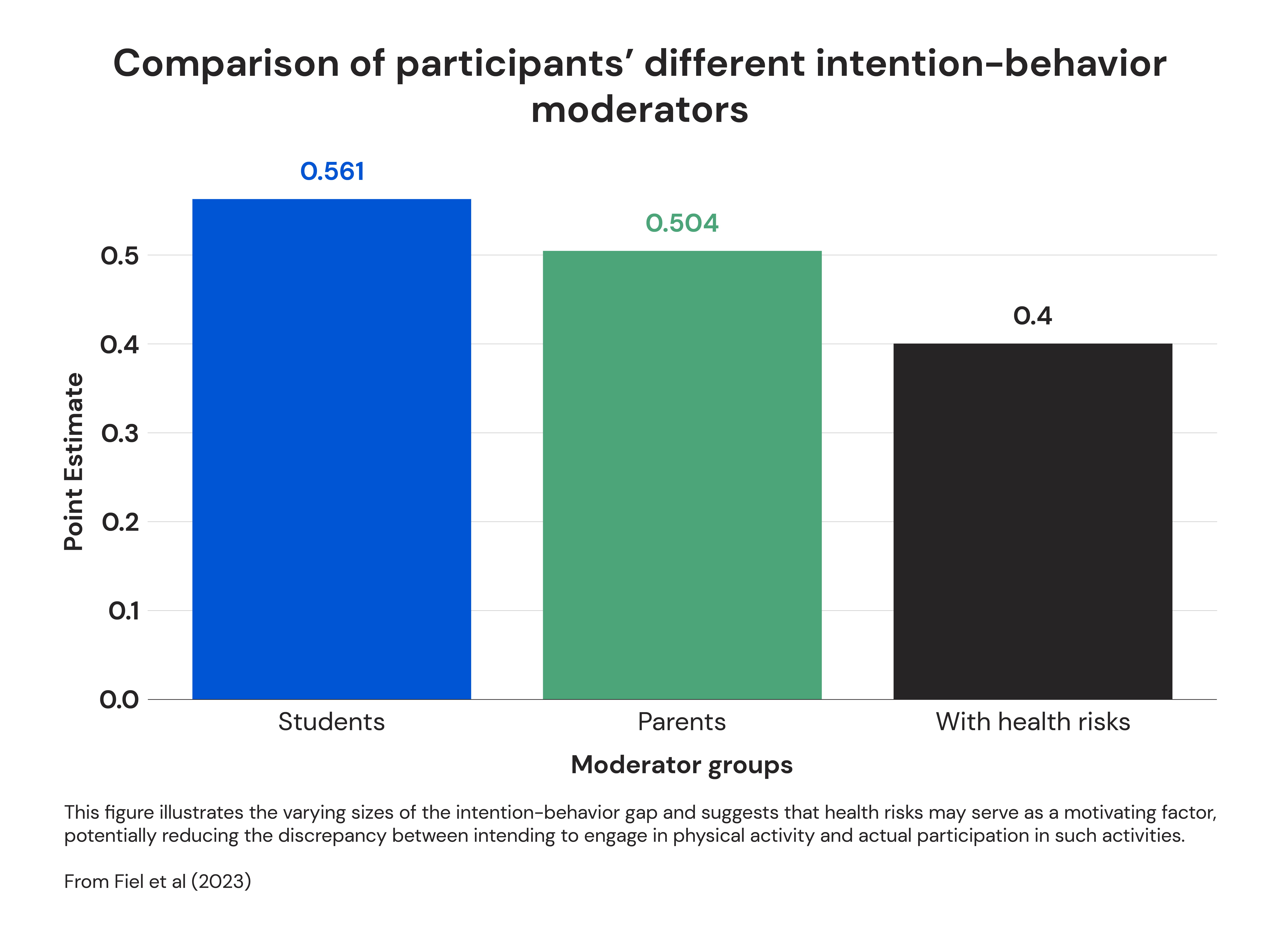
Insights from studies like these highlight the necessity of identifying additional moderators or tools to support our efforts for change. And again, this is especially important for more complex goals like physical activity or weight loss goals.
Having solidified intentions and understanding the role intention moderators play in habit formation is a great place to start. However, if you can add in one more bit of assistance, I’d make it an implementation intention.
Reason #4: You don’t have backup plans for your plans
So, the intention-behavior gap represents the discrepancy between our intentions and our actions. Intention moderators explain the why behind these actions. Now, we introduce implementation intentions. These revolve around how we support purposeful action or respond in the face of barriers.
Implementation intentions link specific situations or cues (the “if” part) with a behavior or action (the “then” part). These plans help you support new behaviors by preparing plans in advance to help you carry out those new behaviors. For now, let’s assume you’re conditioning a habit of walking after dinner. An implementation intention could be, “If I finish putting my plate away in the kitchen, then I will go for a 30-minute walk.”
The if-then approach can also be used for protecting your goals and habit-building against potential barriers, sometimes referred to as coping planning. For example, “If I find myself mindlessly eating a snack, then I will stand up and put the snack away.”
As stated earlier, the more complex the habit we are attempting to condition, the more weapons we will need in our arsenal. Coming at it from that aspect, let’s look at a systematic review and meta-analysis of randomized clinical trials from Silva et al that focused on the impact of implementation intentions on increasing physical activity in adults. It covered 13 eligible studies with participants across various health conditions and revealed that implementation intentions significantly increased physical activity.
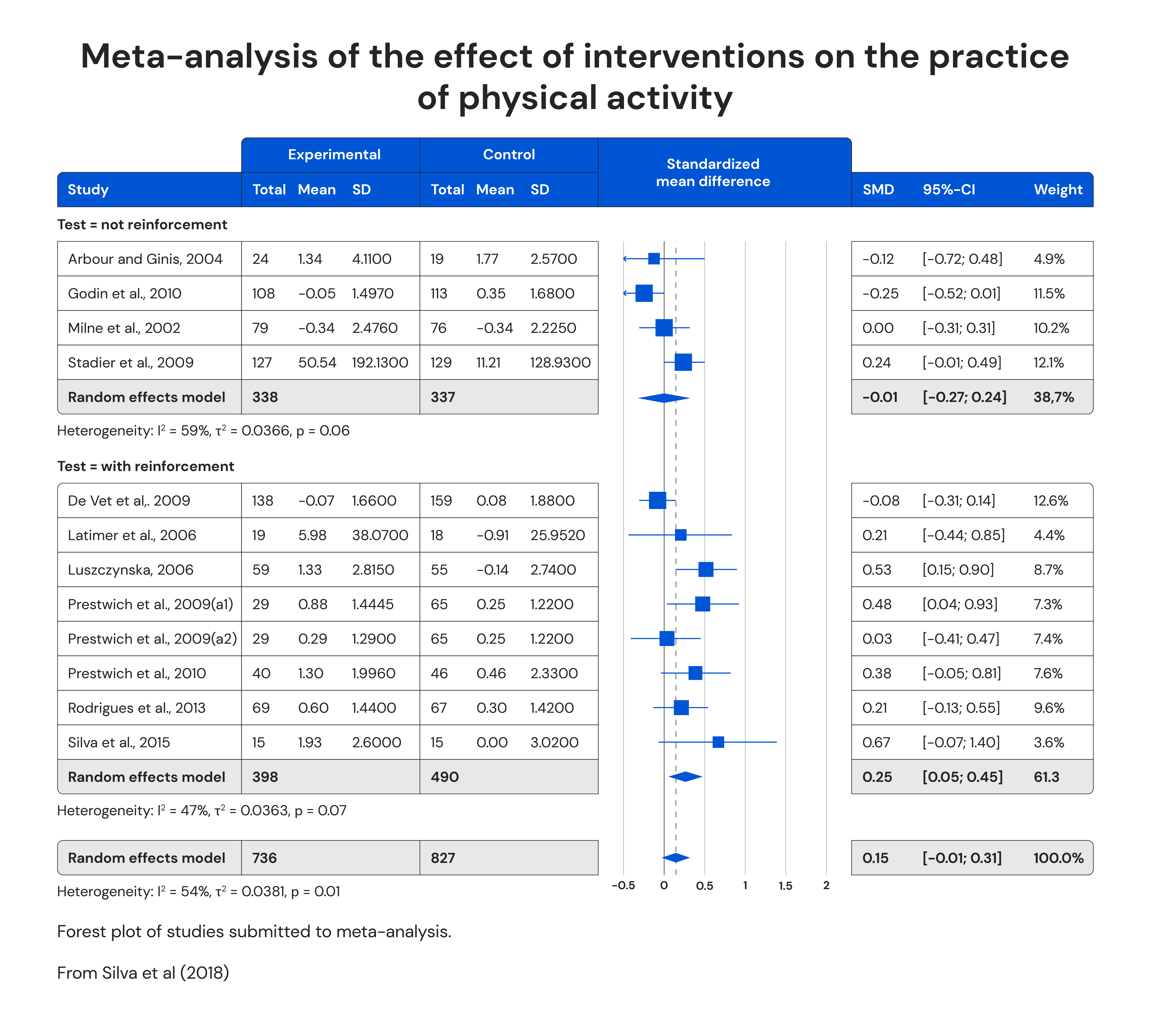
If you look at this forest plot, you’ll see a notable difference between the categorization of “with reinforcement” versus “not reinforcement.” This means that individuals either received some form of follow-up when implementing their intentions or they did not receive any additional feedback or follow-up. For example, reinforcement could be as simple as a text or phone call asking how well people were following through with their implementation intentions. As you can see, reinforcement greatly increased the probability of success.
Implementation intentions help you consistently carry out a new behavior because they allow you to make good decisions at a time when you’re not immediately confronted by temptation. If you’d like to start taking a walk after dinner, it helps to make plans to do so before you finish dinner. After dinner, the couch will probably be looking very cozy, so if you need to make a decision in the moment, it’s more likely that you’ll follow the path of least resistance and be drawn toward the couch. But, at 10AM, the idea of a walk after dinner may seem quite pleasant, and the couch won’t be calling to you quite as loudly. So, that would be a great time to create a plan and make the decision to go for a walk. So, after dinner, it won’t feel like quite as difficult of a choice in the moment – you’ve already decided to go for a walk, and you’ve already created a plan to carry it out. Sticking to the plan is now the path of least resistance, and deviating from the plan (and gravitating toward the couch) would now require a more conscious choice.
That sounds simple and intuitive, but as you can see from the meta-analysis above, implementation intentions without reinforcement weren’t good for much. So, it can help to tell someone else your intentions, so that they can check in with you. For example, you could tell your partner or roommate that you plan to go for a walk after dinner, and ask them to check in with you if you head straight to the couch instead. Or, you could actually write down your implementation intentions, and have a weekly ritual of reviewing your plans and checking in with yourself. Did you go for a walk after dinner every day? If so, great! If not, why not? And can you make further plans to help you overcome obstacles that arose?
For example, maybe you didn’t go for a walk after dinner one day because you were in the middle of a really engaging conversation as you were finishing up the dishes. So, you sat down on the couch to finish the conversation, and never got back up. In that case, you could create a new implementation intention for the next time that situation arises (for example, “if I’m engaged in a great conversation with my partner or roommate after dinner, then I’ll invite them to walk with me to continue the conversation.”). Each time you fail to follow through on your new behavior, check in with yourself (non-judgmentally), and see if you just need to create a new backup plan.
Implementation intentions do make it easier to consistently carry out a new behavior, but creating implementation intentions, planning for obstacles, checking in with yourself, and creating new plans when new challenges arise does certainly take more effort than slipping back into your current behavior patterns that are well-worn and take little conscious thought.
All these elements lead us to an overarching theme of self-awareness and reflecting more deeply on our actions and their motivations. This leads directly to the last point we’re going to cover.
Reason #5: You need to catch habits to make (or break) habits
To this point, we’ve mostly focused on the challenges associated with creating new habits: you need to change your behaviors, and maintain those behavior changes long enough for your new behaviors to become habitual. That takes strong intentions, planning ahead, active effort, and (oftentimes) ongoing maintenance of conscious behaviors that support your new habits. However, we haven’t focused much on breaking “bad” habits, which comes with an additional, particularly tricky challenge.
We’ve examined the benefits of habits and how they can work in your favor. However, some of your ingrained habits may be counterproductive behaviors. It’s important to note that “good or bad” habits can manifest in various ways. For each positive behavior, such as adhering to an exercise regimen or allocating time for reading, there may also be counterproductive habits, such as late-night scrolling on your phone or excessive snacking while watching television. Once again, we are influenced by both our conscious and subconscious behaviors.
Habits operate on a subconscious level, serving to conserve our cognitive and mental resources. You’re not really supposed to notice them. Because of this, catching “triggers” or “cues” for undesirable habits can be challenging. For instance, if you have a habit of snacking while watching television, do you recall when this habit formed? Are you always conscious of reaching for the snacks? It’s not as if you’re existing in a complete subconscious fog, but there are automatic moments and mechanics at play that sustain this habit.
The research on breaking habits doesn’t present a collection of slam-dunk success, especially in complex areas like weight loss. That’s because habits are a lot like gaining knowledge. For example, I’m about to teach you that wombat poop comes out cube-shaped. Scientists theorize that they have cube-shaped poop to prevent it from rolling away and marking their territory, making them “anti-wheel poopers.” Because this is a quirky and memorable piece of information, you’re likely to retain it, or at least remember some animal out there produces cube-shaped poop. It will remain somewhere in your brain, albeit perhaps with some details forgotten. Similarly, habits become deeply ingrained within our physical and mechanical expressions. Their neurobiological underpinnings are rooted in complicated and interwoven networks that can persist even when memory associations falter, as seen in advanced aging disorders.
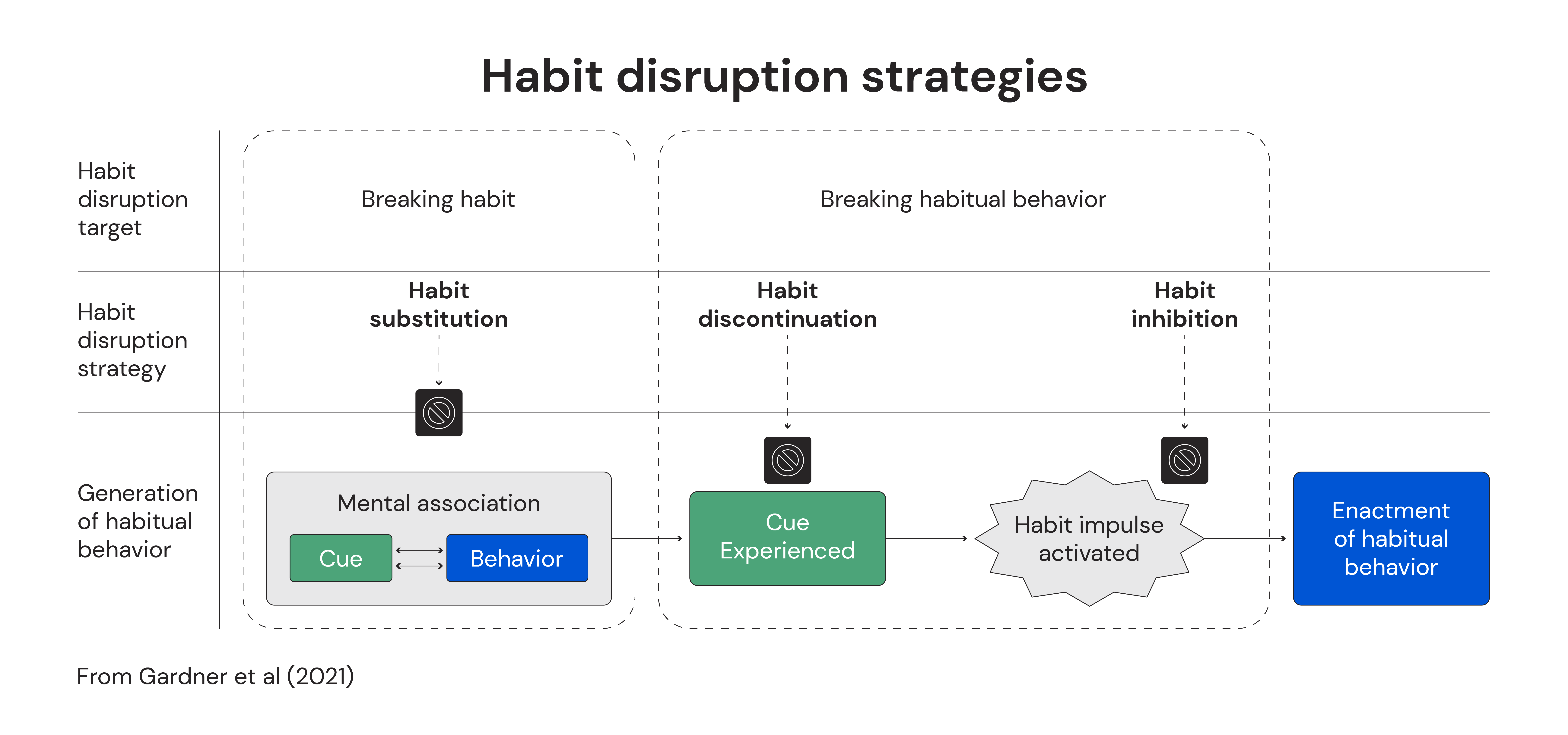
Therefore, removing a learned habit from our cognition ranks on the highest end of the difficulty scale. Stopping a habit is challenging but doable. Replacing or purposefully conditioning a new habit works much better, but it still takes a lot of effort and education. That being said, the more knowledgeable you become about habits, routines, and their interplay, the easier this all becomes.
We will cover this concept more in later articles on habit formation, routine, and environment because, for example, if cues start habits, one tool in our box can be avoiding the cue. But for now, I want you to concentrate on becoming aware of your current habits and the outcomes they produce.
Take home? Reflection and awareness are pretty important to habit change
The habit change journey is complex and takes a multifactorial look at our intentions and behaviors because habit formation is not a standalone process. The habits we aim to form (or alter) are intertwined with our daily actions and mindset. Conditioning habits requires us to examine our reasons, beliefs, and the elements that affect our daily lives.
The critical steps in breaking old habits and fostering new ones rest in the awareness of not only the gap between intention and action, but also how our habits operate in the first place. In doing so, we can utilize our knowledge of moderators and if-then plans to be a base of support in the efforts we’re making along our habit journey.
If you grasp all the reasons behind why forming habits is challenging, you’ll stand a better chance of excelling among those attempting to develop not only simple but also complex habits.
Homework assignment: studies of habit formation
We last left off identifying our habit goals and how our current behaviors were constructive or counterproductive toward our goals. Hopefully, at this point, you have a goal in mind that you’d like to use habit formation to support.
This section will provide examples of individuals demonstrating awareness of their habits, identifying the reasons behind their goals, and devising implementation intentions to support their journey of habit formation.
Case study 1: Increase physical activity via walking after dinner
Casey is a 44-year-old freelance graphic designer who works from home and wants to counteract a sedentary lifestyle by incorporating more physical activity into their daily routine. Their objective is to add a 30-minute walk after dinner each day.
Catch a habit related to your goal: “After dinner, I immediately go into the TV room. It’s clockwork and without thought. I can be in there for hours.”
Identify three strong reasons that support your intentions:
- I’m getting older and worry more about my health and circulation. I know movement is good for me.
- I wouldn’t mind losing a few pounds, and this would probably help with that too.
- I like being outdoors and having some time to focus on things I like. It improves my mood.
Come up with an if/then plan to support your habit: “If I get the chance earlier in the day, then I will download all my podcasts ahead of time to have something to listen to.”
Come up with an if/then plan if a barrier appears: “If it’s raining outside, then I will spend 30 minutes doing an indoor workout video or use the treadmill if available.”
Case study 2: Eliminate high-calorie snacking while watching TV/streaming
Riley is a 30-year-old account manager who tends to snack on high-calorie food while watching TV or streaming movies. Riley’s goal is to eliminate this habit, hoping it will also help meet their goal of losing 20 pounds of fat.
Catch a habit related to your goal: “I automatically reach for snacks when I sit down to watch TV, without being truly hungry.”
Identify three strong reasons that support your intentions:
- I’ve been gaining weight faster lately, and this isn’t helping. At the very least, I’d like to stop the gaining.
- I don’t like the idea of eating mindlessly, and it can bleed over into drinking a little sometimes as well. It doesn’t feel like a healthy habit for me.
- Snacks aren’t as cheap as they used to be, and I think I’d resent my grocery bill less if I cut some of these items out.
Come up with an if/then plan to support your habit: “If I have to snack, then I will make a vegetable platter with low-calorie dips.”
Come up with an if/then plan if a barrier appears: “If I don’t have vegetables for my platter, then I’ll make some herbal tea with a little bit of honey.”
Your assignment:
At the end of each article, take a moment to document each insight lesson for your journey. How can you relate this to your current habits and behaviors using the framework provided? The point of this article is to encourage you to examine your habits, reasons, and plans. For each habit, devise if/then plans that can help you stick to your goals even when you face challenges. Lastly, reflect on how the strategies used by Casey and Riley can be adapted to suit your circumstances.

